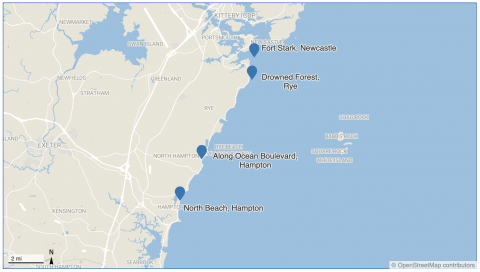- When foraging seaweeds for personal use, be aware of pertinent state regulations, do your research and use common sense when looking for safe, clean sites to harvest.
- Harvest each organism in a way that allows it to regenerate and reproduce. Do not pull seaweeds or damage or remove them by their holdfast. Never harvest more than 25% of the seaweed in a stand.
- Depending on the species of seaweed you are harvesting, only cut the tips. Look for fresh, healthy, "floating" seaweeds, as these are easier to collect and still edible.
- Do not go to the same harvesting site repeatedly; give the site time to recover.
- Always use what you collect, never collect more than you can use, and remember to enjoy!
Seaweed Foraging Site Suggestions
Important Disclaimer: This map depicts SUGGESTIONS ONLY! There are many places along the New Hampshire coast to forage for and collect seaweed. Seaweed foragers should avoid excessive harvesting from any one area in order to preserve the seaweed resource for all. Seaweed harvesting is not allowed on NH State Park or NH State Beach property; for example, at the Drowned Forest site, you can only harvest on non-park portions. If you have any questions about seaweed harvesting regulations, contact NH Fish & Game for clarification.

Seaweed Foraging FAQs
In the State of New Hampshire, you may wild harvest seaweed for your own personal use/consumption up to 3 bushels/person/day (equivalent to 64 pints or 35.2 liters). Always take what you will reasonably need. Do not collect large quantities only to let it go to waste. Will you really use 3 bushels? Likely not. Do not take large amounts from one site. Take small bits from several different spots.
They are the same! Seaweeds are often called sea vegetables (or sea veggies) if they are heading to your plate.
There does not appear to be any poisonous seaweeds along the coast of New Hampshire, although not all seaweeds are good to eat. Some have high iodine concentrations, so please consult with your doctor if you have a thyroid condition or other health questions/concerns before exploring seaweed consumption. Other seaweed species have high concentrations of hydrogen sulfide when decomposing, so these species would not be good to put on your garden.
Yes, up to three bushels a day in New Hampshire.
NH Sea Grant does not test the water quality for seaweed harvest, but you can always call the NH Department of Environmental Services (NHDES) and check water quality for different beaches. Usually, high wave action coastlines with easy access to the intertidal zone at low tide are safe places to harvest. Busy harbors and areas with high boat traffic areas not recommended for seaweed harvesting.
Harvesters should be aware of shellfish closures and potential changes to water quality, although not all affect seaweed or affect seaweed in the same way. Biotoxins that we associate with shellfish (PSP, ASP, etc.) are accumulated when the shellfish filter feeds on toxin-containing algae. Since seaweeds aren’t filler feeders and don’t eat/accumulate algae, these types of closures would be less of a concern. For bacteria (e.g. Vibrio and E. coli) we are currently in the process of learning if and how edible seaweeds are affected by these.
Preliminary results have shown that some of these bacteria can live on the surface of the seaweed, although they have only been found in very low quantities, with local water samples containing significantly more of these bacteria than are found on the kelp. Like any bacteria, time and temperature are key considerations, so we encourage seaweed harvesters to keep wild harvested seaweeds cool, not to store in freshwater (this will degrade them), and cut them only when you’re ready to eat/prepare. Heat will kill many of these bacteria also, so if you plan on cooking with the seaweeds this will also minimize any risk.
NH Sea Grant does not test wild seaweed for heavy metals. Seaweeds will accumulate heavy metals if the heavy metals are in the water the seaweeds grow in. Seaweed companies, such as Maine Coast Sea Vegetables in Maine, routinely test their products for heavy metals and post results on their website.
Different species of seaweed contain different concentrations of iodine. For example, kelps have a lot more iodine than red seaweeds (like dulse). Horsetail kelp (Laminaria digitata) has particularly high iodine concentrations. If you have a known thyroid condition or other health questions/concerns, always check with your doctor before making changes to your diet to incorporate for seaweed.
For consumption and culinary use, seaweed in the high tide line (also called the "wrack line") is not safe. The seaweed along the high tide line is often dried out and/or has begun to decompose, so you risk getting sick. This seaweed is better used as compost for you garden.
You can collect seaweeds that have naturally detached from the rocks as long as it is a new detachment, meaning that it looks fresh. If the blades have blanched or discolored spots, are very ragged, have bryozoans or snails on them, or smell, do not collect this floating seaweed for consumption. If it doesn't look fresh, it probably isn't. If you are at all hesitant, err on the side of caution and do not collect it.
This is a rule from the NH Department of Fish & Game for your safety.
Yes, seaweed contains nutrients that are excellent for your garden!
Some residual salt is okay for a garden, however we recommend thoroughly rinsing or hosing down seaweed with freshwater before spreading it on your garden.
